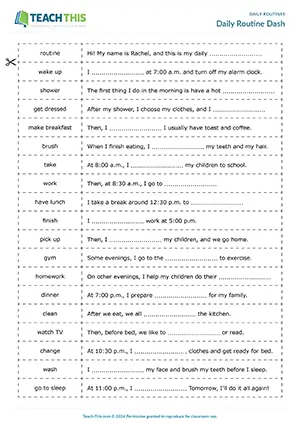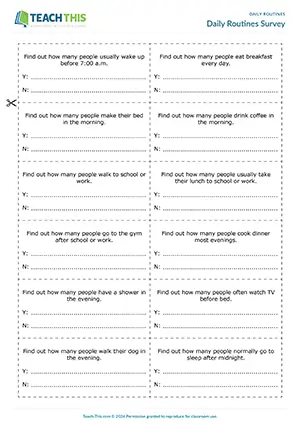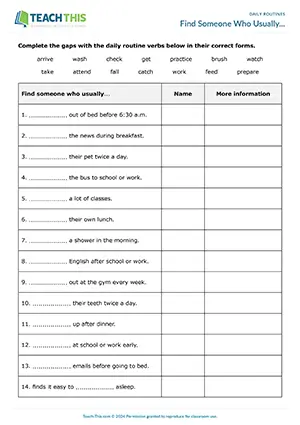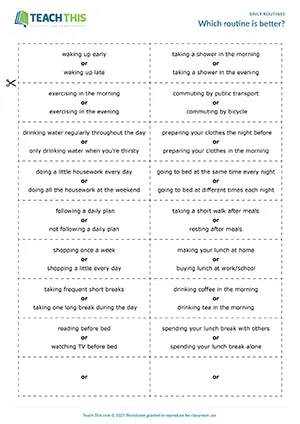Daily Routines ESL Games, Activities & Worksheets
Daily Routines Board Game

ESL Daily Routines Board Game - Vocabulary and Speaking: Gap-fill, Impromptu Speech, Freer Practice - Group Work
In this free daily routines board game, students practice vocabulary related to daily routines and talk in response to topic-related prompts. Players take turns rolling the dice and moving their counters...
Daily Routine Dash

ESL Daily Routines Games - Vocabulary and Reading: Matching, Pelmanism, Gap-fill, Ordering - Pair Work
In these fun daily routines games, students complete sentences with vocabulary related to daily activities and then race to put the sentences in order to create a text about someone's daily routine...
Daily Routines Survey

ESL Daily Routines Activity - Speaking: Forming, Asking and Answering Questions, Controlled Practice - Group Work
In this insightful daily routines activity, students conduct a survey where they ask and answer 'Do you...?' questions about daily routines. First, each student creates the daily routine 'Do you...?' question...
Daily Routine Vocabulary

ESL Daily Routines Worksheet - Vocabulary and Writing Exercises: Binary Choice, Matching, Error Correction, Gap-fill, Writing a Paragraph
Here is a useful daily routines worksheet to help students practice vocabulary related to daily routines. Students begin by discussing three questions about daily...
Find Someone Who Usually...

ESL Daily Routines Activity - Vocabulary and Speaking: Gap-fill, Asking and Answering Questions, Controlled and Freer Practice
In this engaging daily routines speaking activity, students ask and answer questions about their daily routines and habits. First, students complete 'Find someone who...' prompts with daily routine...
Daily Life Discussion

ESL Daily Routines Activity - Vocabulary and Speaking: Asking and Answering Questions, Discussion, Freer Practice - Group Work
Here is a daily routines discussion activity that helps students practice vocabulary related to daily routines and discuss their habits and routines. In groups, students take turns picking up a card and asking the...
Which Routine is Better?

ESL Daily Routines Activity - Speaking: Asking and Answering Questions, Discussion, Freer Practice - Group Work
In this daily routines discussion activity, students use comparative structures to express and justify preferences about daily routines. In groups, students take turns picking up a card and asking...
Eco-Friendly Daily Routines

ESL Daily Routines Worksheet - Vocabulary Exercises: Matching, Binary Choice, Gap-fill - Speaking Activity: Asking and Answering Questions, Freer Practice - Pair Work
Here is an informative daily routines worksheet to help students learn and practice verbs related to eco-friendly daily routines. Students begin by...
Routine Reset

ESL Daily Routines Activity - Listening and Speaking: Planning and Delivering a Short Talk, Peer Review, Freer Practice - Pair Work
In this daily routines speaking activity, students give short talks about a routine change they have made, contrast the present perfect simple and continuous, and use sequencing and result language...

